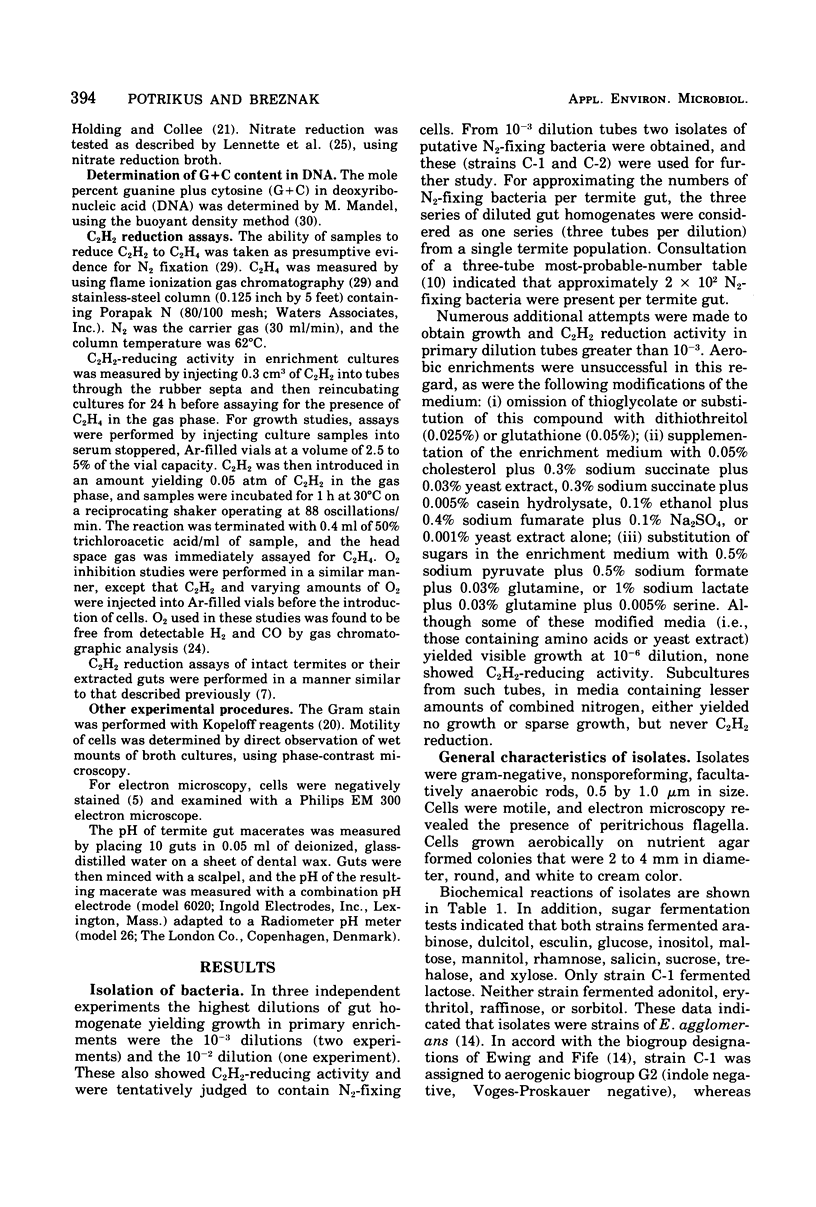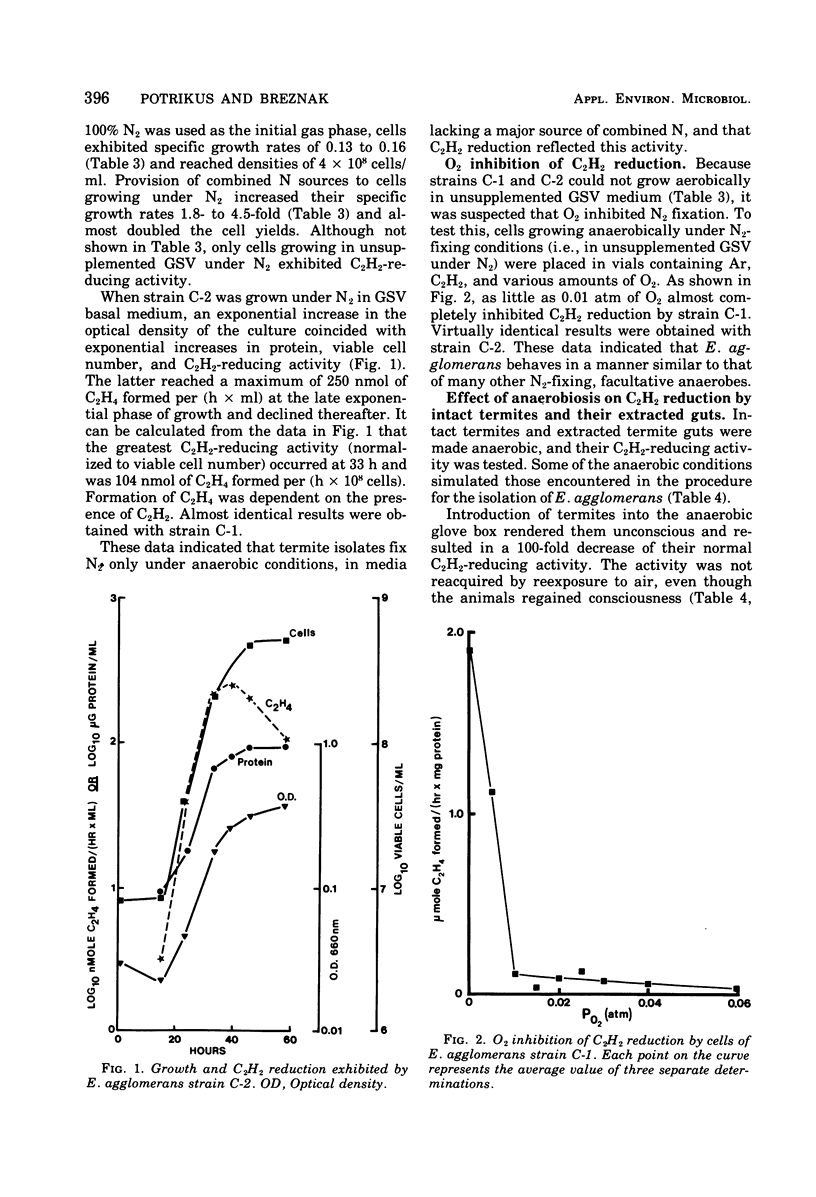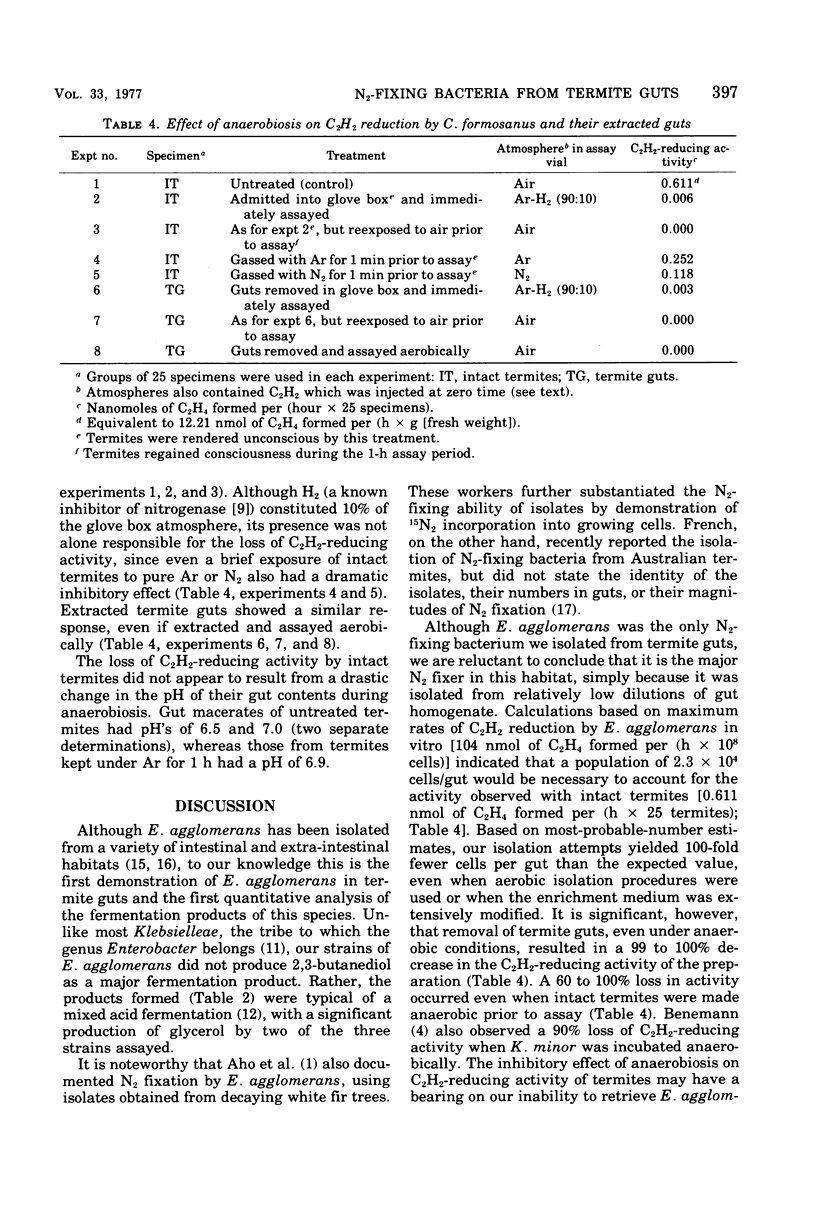Abstract
Two strains of facultatively anaerobic, N2-fixing bacteria were isolated from guts of Coptotermes formosanus and identified as Enterobacter agglomerans. The deoxyribonucleic acid base composition of isolates was 52.6 and 53.1 mol% guanine plus cytosine. Both isolates and a known strain of E. agglomerans carried out a mixed acid type of glucose fermentation. N2 fixation by E. agglomerans was inhibited by O2; consequently, N2 served as an N source only for cells growing anaerobically in media lacking a major source of combined N. However, peptone, NH4Cl, or KNO3 served as an N source under either aerobic or anaerobic conditions. It was estimated that 2 x 10(2) cells of E. agglomerans were present per termite gut. This value was 100-fold lower than expected, based on N2 fixation, low recoveries of E. agglomerans may be related to the marked decrease in N2 fixation rates observed when intact termites or their extracted guts were manipulated for the isolation of bacteria. It was concluded that the N2-fixing activity of E. agglomerans may be important to the N economy of C. formosanus.
Full text
PDF







Selected References
These references are in PubMed. This may not be the complete list of references from this article.
- Arank A., Syed S. A., Kenney E. B., Freter R. Isolation of anaerobic bacteria from human gingiva and mouse cecum by means of a simplified glove box procedure. Appl Microbiol. 1969 Apr;17(4):568–576. doi: 10.1128/am.17.4.568-576.1969. [DOI] [PMC free article] [PubMed] [Google Scholar]
- BRENNER S., HORNE R. W. A negative staining method for high resolution electron microscopy of viruses. Biochim Biophys Acta. 1959 Jul;34:103–110. doi: 10.1016/0006-3002(59)90237-9. [DOI] [PubMed] [Google Scholar]
- Benemann J. R. Nitrogen fixation in termites. Science. 1973 Jul 13;181(4095):164–165. doi: 10.1126/science.181.4095.164. [DOI] [PubMed] [Google Scholar]
- Breznak J. A., Brill W. J., Mertins J. W., Coppel H. C. Nitrogen fixation in termites. Nature. 1973 Aug 31;244(5418):577–580. doi: 10.1038/244577a0. [DOI] [PubMed] [Google Scholar]
- Breznak J. A., Pankratz H. S. In situ morphology of the gut microbiota of wood-eating termites [Reticulitermes flavipes (Kollar) and Coptotermes formosanus Shiraki]. Appl Environ Microbiol. 1977 Feb;33(2):406–426. doi: 10.1128/aem.33.2.406-426.1977. [DOI] [PMC free article] [PubMed] [Google Scholar]
- Breznak J. A. Symbiotic relationships between termites and their intestinal microbiota. Symp Soc Exp Biol. 1975;(29):559–580. [PubMed] [Google Scholar]
- HUNGATE R. E. The anaerobic mesophilic cellulolytic bacteria. Bacteriol Rev. 1950 Mar;14(1):1–49. doi: 10.1128/br.14.1.1-49.1950. [DOI] [PMC free article] [PubMed] [Google Scholar]
- Macy J. M., Snellen J. E., Hungate R. E. Use of syringe methods for anaerobiosis. Am J Clin Nutr. 1972 Dec;25(12):1318–1323. doi: 10.1093/ajcn/25.12.1318. [DOI] [PubMed] [Google Scholar]
- Pinter J. K., Hayashi J. A., Watson J. A. Enzymic assay of glycerol, dihydroxyacetone, and glyceraldehyde. Arch Biochem Biophys. 1967 Aug;121(2):404–414. doi: 10.1016/0003-9861(67)90094-x. [DOI] [PubMed] [Google Scholar]
- SCHILDKRAUT C. L., MARMUR J., DOTY P. Determination of the base composition of deoxyribonucleic acid from its buoyant density in CsCl. J Mol Biol. 1962 Jun;4:430–443. doi: 10.1016/s0022-2836(62)80100-4. [DOI] [PubMed] [Google Scholar]
- Starr M. P., Mandel M. DNA base composition and taxonomy of phyopathogenic and other enterobacteria. J Gen Microbiol. 1969 Apr;56(1):113–123. doi: 10.1099/00221287-56-1-113. [DOI] [PubMed] [Google Scholar]
- WOLIN E. A., WOLIN M. J., WOLFE R. S. FORMATION OF METHANE BY BACTERIAL EXTRACTS. J Biol Chem. 1963 Aug;238:2882–2886. [PubMed] [Google Scholar]


